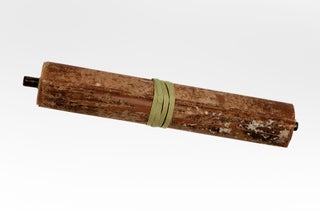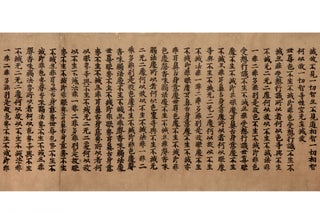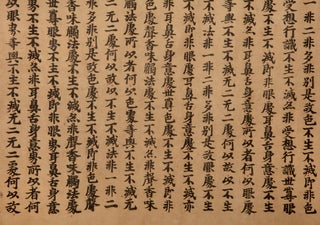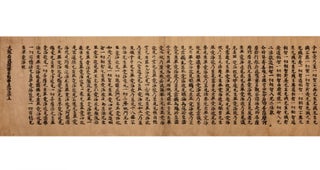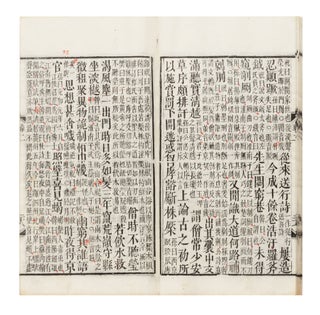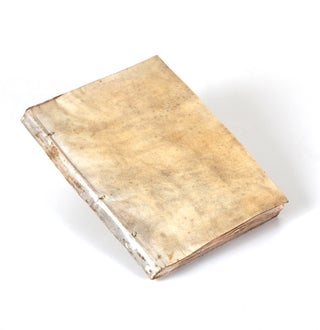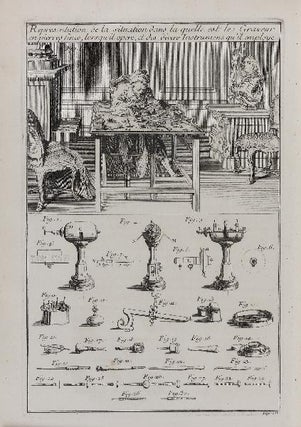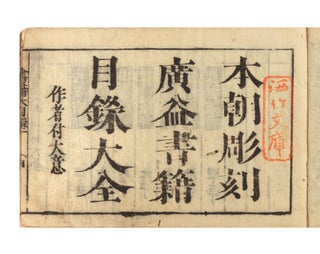13th-Century Printing
Block-printed scroll of Vol. 423 of the Sutra on the Great Perfection of Wisdom or Mahaprajnaparamitasutra, text starting “Daihannya haramitta kyo…”.
20-24 columns per sheet, 17 characters per column (column height 203-04 mm.), printed on 19 joined sheets (263 mm. high, sheet lengths from 382 to 443 mm., total length 8170 mm.), attached at end to a wooden roller. [Nara: 1222-27].
A rare early printed sutra scroll, part of the Karoku-ban edition printed in 1222-27. It has been printed on high-quality thick paper (gampi, or mulberry fibers), and printed in bold, thick strokes, using black sumi ink, typical of Kamakura and Muromachi kasuga-ban printings (kasuga-ban is a general term for publications of the Nara monasteries).
The Mahaprajnaparamitasutra is a massive compilation of scriptural literature said to have been preached by the Buddha in four different places to 16 discrete assemblies. It includes seminal works such as the Prajnaparamita in One Hundred Thousand Lines and the Diamond Sutra. “This recension of the scripture is only extant in a Chinese translation made in six hundred rolls by Xuanzang and his translation team between the years 660 and 663. Xuanzang’s recension is by far the largest of all the prajnaparamita scriptures in the Chinese Buddhist canon…The Mahaprajnaparamitasutra also often holds pride of place as the first sutra found in many traditional East Asian Buddhist scriptural canons.”–Buswell & Lopez, eds., The Princeton Dictionary of Buddhism, p. 505.
Xuanzang (600/02-64), Chinese monk, pilgrim, and patriarch of the Chinese Yagara tradition, was one of the two most influential and prolific translators of Indian Buddhist texts into Chinese, along with Kumarajiva. Xuanzang made an epic journey to India in 629, where he studied Sanskrit, and returned to China in 645 with a quantity of scriptures in his luggage for study and translation.
The Karoku-ban edition was published from Jouo 1 (1222) to Karoku 3 (1227). For a brief discussion of this edition, see Nobuko Inagi, “The Printing and Circulation of Buddhist Scriptures during the Kamakura Period: With Special Attention to the Kasuga Edition of the Sutra of Great Wisdom (Daihannyakyo)” in Bulletin of the National Museum of Japanese History, Vol. 72 (March 1997), pp. 34-35.
A very good copy, with some minor worming repaired, preserved in a box. This was sold by Colin Franklin to a private collector.
❧ K.B. Gardner, “Centres of Printing in Medieval Japan: late Heian to early Edo period” in British Library Occasional Papers 11. Japanese Studies (ed. by Yu-Ying Brown), London: 1990, p. 159–”The term Kasuga-ban became used more loosely, in a wider sense, to denote publications of the Nara monasteries in general, not only of the Kofukuji. The printing of Kasuga-ban in this broader sense flourished throughout the Kamakura period and up to the end of Muromachi ca. 1570.” Mizuno, Buddhist Sutras. Origin, Development, Transmission, pp. 178-79.
Price: $15,000.00
Item ID: 7630


